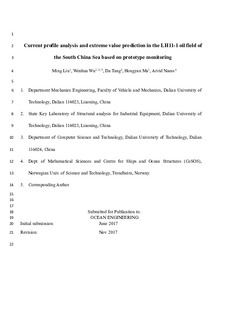| dc.contributor.author | Liu, Ming | |
| dc.contributor.author | Wu, Wenhua | |
| dc.contributor.author | Tang, Da | |
| dc.contributor.author | Ma, Hongyan | |
| dc.contributor.author | Næss, Arvid | |
| dc.date.accessioned | 2019-02-11T10:32:41Z | |
| dc.date.available | 2019-02-11T10:32:41Z | |
| dc.date.created | 2018-10-20T20:12:17Z | |
| dc.date.issued | 2018 | |
| dc.identifier.citation | Ocean Engineering. 2018, 153 60-70. | nb_NO |
| dc.identifier.issn | 0029-8018 | |
| dc.identifier.uri | http://hdl.handle.net/11250/2584749 | |
| dc.description.abstract | Current is a key ocean-environmental factor and exhibits strong non-stationary random characteristics. The complexities of current modeling present significant challenges for deep sea oil exploitation. The multiyear return period extreme current model is one of the key factors for the reliable design of marine structures. Recently, due to limitations of design specifications and guidelines, improved methods to predict extreme values for the South China Sea based on prototype monitoring are required. In contrast to the traditional extreme value analytical method, the newly developed Average Conditional Exceedance Rate (ACER) method is robust and shows good accuracy for estimations of ocean environmental loading. The method offers good reliability for short-term prototype monitoring data. This study performs multiyear return period extreme value prediction of the current profile based on prototype monitoring data collected in the Liuhua (LH11-1) oil field that was recorded by an in-situ monitoring system. The 1-year and 10-year return period current velocity design indexes were obtained using the ACER method. The present current velocity profiles of multi-year return periods were compared with two design current load indexes of two floating platforms in Liuhua area. The consistency with comparison to TLP platform design indexes shows that the ACER method provides the accuracy and flexibility of the results needed in the construction of current load models in the South China Sea. These results could provide the basis and reference for the design of offshore structure. | nb_NO |
| dc.language.iso | eng | nb_NO |
| dc.publisher | Elsevier | nb_NO |
| dc.rights | Attribution-NonCommercial-NoDerivatives 4.0 Internasjonal | * |
| dc.rights.uri | http://creativecommons.org/licenses/by-nc-nd/4.0/deed.no | * |
| dc.title | Current profile analysis and extreme value prediction in the LH11-1 oil field of the South China Sea based on prototype monitoring | nb_NO |
| dc.type | Journal article | nb_NO |
| dc.type | Peer reviewed | nb_NO |
| dc.description.version | acceptedVersion | nb_NO |
| dc.source.pagenumber | 60-70 | nb_NO |
| dc.source.volume | 153 | nb_NO |
| dc.source.journal | Ocean Engineering | nb_NO |
| dc.identifier.doi | 10.1016/j.oceaneng.2018.01.064 | |
| dc.identifier.cristin | 1621949 | |
| dc.description.localcode | © 2018. This is the authors’ accepted and refereed manuscript to the article. Locked until 04.02.2020 due to copyright restrictions. This manuscript version is made available under the CC-BY-NC-ND 4.0 license http://creativecommons.org/licenses/by-nc-nd/4.0/ | nb_NO |
| cristin.unitcode | 194,63,15,0 | |
| cristin.unitname | Institutt for matematiske fag | |
| cristin.ispublished | true | |
| cristin.fulltext | postprint | |
| cristin.qualitycode | 1 | |

